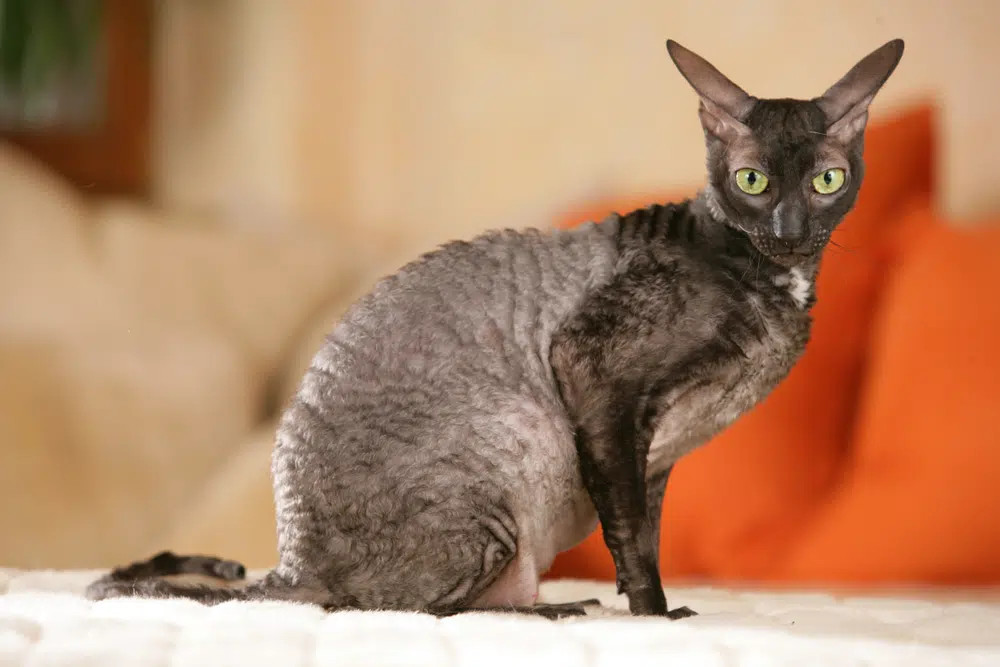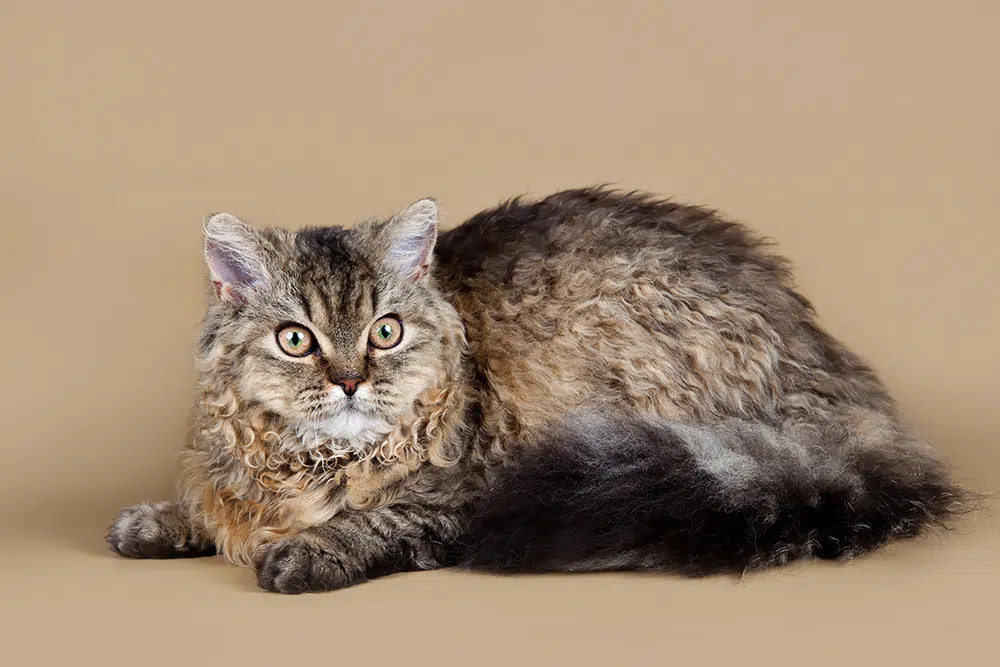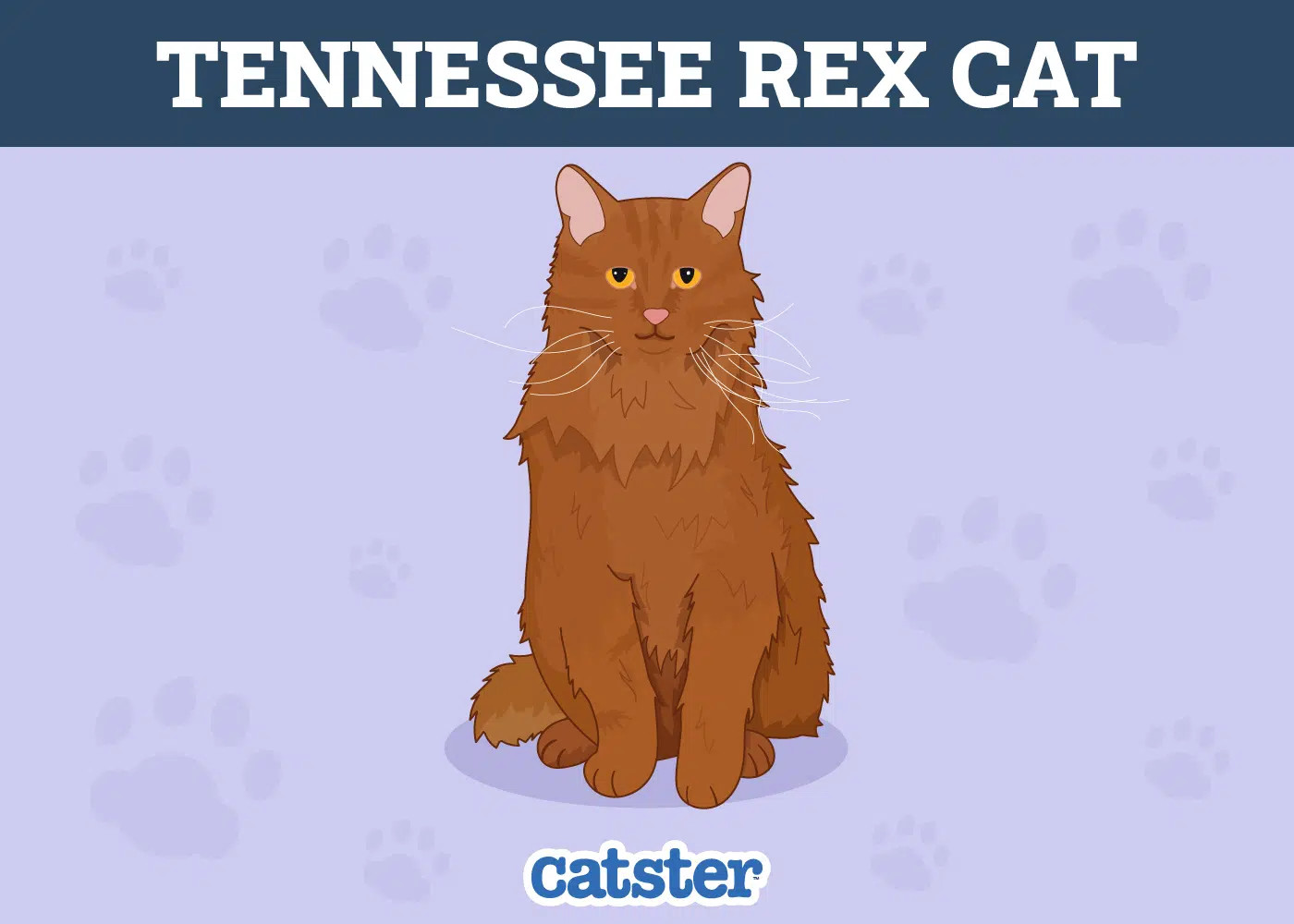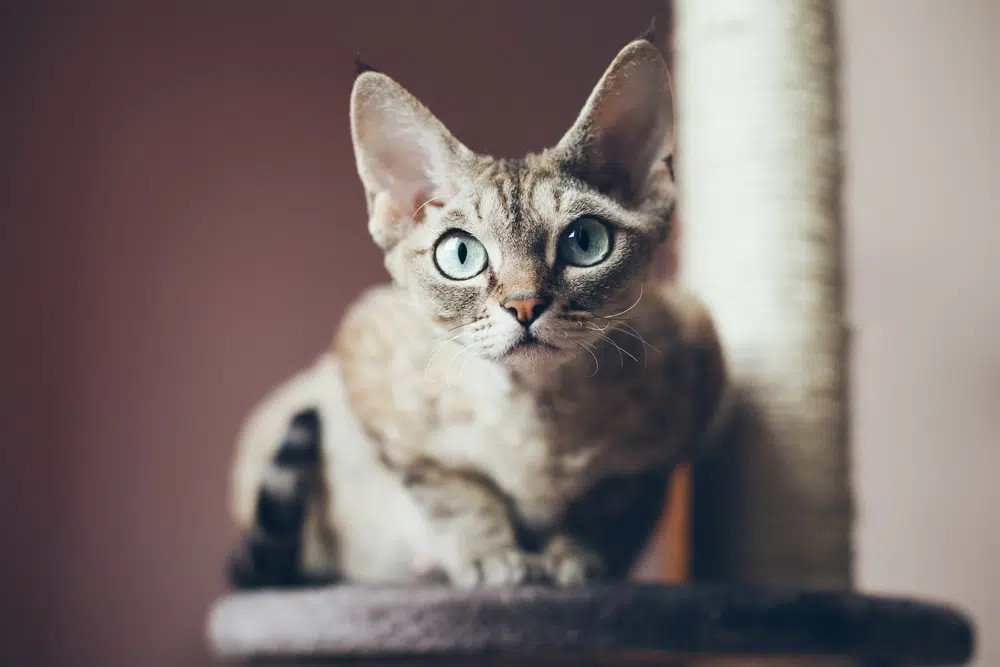While many picture cats with sleek, straight fur, the world of felines is wonderfully diverse. Rex Cats stand out with their distinctive curly coats, a genetic mutation that results in waves and ringlets rather than the typical smooth fur. If you’re intrigued by these unique felines, you’re in for a treat! There isn’t just one type of Rex cat; in fact, several breeds boast this special curly characteristic. From short-haired to long-haired varieties and a spectrum of colors, Rex cats offer a fascinating glimpse into feline genetics and breed variation. Originating from different corners of the globe, each Rex breed has its own story and set of traits. Let’s explore ten captivating types of rex cats, each with its own charm and appeal.
1. Devon Rex
 A slender Devon Rex cat with large ears poses sideways, showcasing its short, curly coat.
A slender Devon Rex cat with large ears poses sideways, showcasing its short, curly coat.
| Height | 10 to 12 inches |
|---|---|
| Weight | 6 to 9 pounds |
| Lifespan | 9 to 15 years |
The Devon Rex is among the select few Rex cat breeds formally recognized by the Cat Fanciers Association (CFA). Originating in Devonshire, England, this breed is known for its playful and affectionate nature, making them wonderful companions for individuals and families alike. Devon Rex cats are known to bond strongly with their families and generally get along well with children and other pets, exhibiting a sociable and adaptable temperament.
Their appearance is as striking as their personality. Devon Rex cats sport a short, wavy coat that feels incredibly soft to the touch, sometimes described as suede-like. Adding to their unique look are their large ears, often described as “butterfly” ears due to their wide set and rounded tips, and their short muzzles which differ noticeably from other Rex breeds. You can find Devon Rexes in a wide array of colors and patterns, including black, white, red, cream, chocolate, and tabby variations, ensuring there’s a Devon Rex to suit almost every preference.
2. Cornish Rex
 A sleek black Cornish Rex cat with large ears and wavy fur gazes intently.
A sleek black Cornish Rex cat with large ears and wavy fur gazes intently.
| Height | 8 to 12 inches |
|---|---|
| Weight | 6 to 10 pounds |
| Lifespan | 11 to 15 years |
Another Rex breed enjoying recognition from the Cat Fanciers Association, the Cornish Rex hails from Cornwall, England. Cornish Rex cats are distinguished by their elegant, slender bodies, long legs, and exceptionally large ears, giving them an almost ethereal appearance. Their fur is perhaps their most defining feature – incredibly soft, fine, and wavy, lying close to the body and lacking guard hairs, which are present in many other cat breeds. This unique coat texture is a result of a different genetic mutation than that of the Devon Rex, despite their shared “Rex” designation.
Beyond their looks, Cornish Rex cats are known for their boundless energy and intelligence. They are highly active and playful, often described as kitten-like well into adulthood. These intelligent felines are also known for their affectionate and people-oriented nature, thriving on interaction and forming strong bonds with their families. They are well-suited to family life, often getting along famously with children and other friendly pets, including other cats. Their playful nature and desire for attention mean they are best suited to homes where they will receive plenty of interaction and mental stimulation.
3. Selkirk Rex
 A fluffy Selkirk Rex cat with a dense, curly coat sits against a warm brown background.
A fluffy Selkirk Rex cat with a dense, curly coat sits against a warm brown background.
| Height | 9 to 11 inches |
|---|---|
| Weight | 6 to 16 pounds |
| Lifespan | 15 to 20 years |
Completing the trio of CFA-recognized Rex cat breeds, the Selkirk Rex stands apart in both origin and appearance. Unlike the Devon and Cornish Rex, which have European roots and somewhat similar appearances, the Selkirk Rex lineage traces back to Montana, USA. This breed is characterized by its plush, dense, and curly coat, often described as sheep-like due to its volume and texture. The curliness is not just limited to their outer coat; even their whiskers and eyebrows are curly, contributing to their distinctive, almost tousled look.
Selkirk Rex cats are typically larger and more robust in build compared to the Devon and Cornish Rex. They come in both short-haired and long-haired varieties, each exhibiting the characteristic curly coat. Known for their laid-back and affectionate personalities, Selkirk Rex cats are often described as “teddy bear” cats due to their cuddly appearance and gentle nature. They are generally tolerant and patient, making them excellent family pets who get along well with children and other animals. Their easygoing nature and love for affection make them wonderful companions for those seeking a cuddly and relaxed feline friend.
4. German Rex
 A close-up of a German Rex cat with a focused gaze, highlighting its soft, wavy fur.
A close-up of a German Rex cat with a focused gaze, highlighting its soft, wavy fur.
| Height | 10 to 12 inches |
|---|---|
| Weight | 6 to 10 pounds |
| Lifespan | 9 to 14 years |
Originating in Germany, as their name suggests, the German Rex is a charming breed known for its wavy coat and sociable temperament. While not currently recognized by the Cat Fanciers Association, the German Rex has gained popularity across Europe and beyond. This breed is characterized by its soft, silky, and wavy to curly coat, which is shorter than that of the Selkirk Rex but more substantial than the fine coat of the Cornish Rex. German Rex cats come in a wide variety of colors and patterns, adding to their visual appeal.
German Rex cats are known for their affectionate, people-oriented, and intelligent personalities. They are generally sociable and get along well with families, children, and other pets, making them adaptable to various household environments. Often described as playful and curious, they enjoy interactive play and exploring their surroundings. Compared to some other Rex breeds, they are often considered relatively low-maintenance in terms of grooming, making them a good choice for those seeking a loving and engaging cat without demanding extensive upkeep.
5. Tennessee Rex
 An artistic illustration of a Tennessee Rex cat, emphasizing its uniquely textured and patterned coat.
An artistic illustration of a Tennessee Rex cat, emphasizing its uniquely textured and patterned coat.
| Height | Medium to large |
|---|---|
| Weight | 8 to 15 pounds |
| Lifespan | 12 to 18 years |
The Tennessee Rex, sometimes affectionately called the T-Rex, is a relatively new and developing breed, first appearing in 2004 in, as the name suggests, Tennessee, USA. This breed emerged from a natural mutation within the feral cat population, discovered by Franklin Wittenburg. Genetic testing confirmed that the Tennessee Rex’s curly, soft fur is indeed the result of a unique genetic variation. The International Cat Association (TICA) recognized the Tennessee Rex as a provisional new breed in 2009, marking an important step in its breed development journey.
What sets the Tennessee Rex apart is its distinctive coat texture, described as satiny and sometimes even sparkly in appearance. While the coat texture is consistent across the breed, Tennessee Rex cats can exhibit any coat color and pattern, offering a diverse range of appearances within the breed. Beyond their striking coats, these cats are celebrated for their gentle, easygoing, and loving temperaments. They are known to be affectionate and enjoy human companionship, making them wonderful family pets.
6. LaPerm Rex
 A LaPerm Rex cat with a chocolate silver tortie tabby coat against a dark black backdrop.
A LaPerm Rex cat with a chocolate silver tortie tabby coat against a dark black backdrop.
| Height | 6 to 10 inches |
|---|---|
| Weight | 8 to 10 pounds |
| Lifespan | 10 to 15 years |
The LaPerm Rex is a breed known for its charmingly tousled, curly coat and, in some cases, smaller stature. Originating in the United States, the LaPerm is characterized by its curls, which can range from loose waves to tight ringlets and can be present in both short and long-haired varieties. The coat texture can vary considerably, even within the same litter, adding to the breed’s unique appeal. LaPerm Rex cats come in a wide array of colors and patterns, including black, white, blue, cream, red, and tortoiseshell, offering a diverse palette of looks.
Despite their sometimes-unruly appearance, LaPerm Rex cats are known for their affectionate and gentle personalities. They are typically active and playful but also enjoy cuddling and spending time with their human families. While their breeding numbers are relatively low, making them less common than some other Rex breeds, their unique look and endearing personalities have garnered a dedicated following among cat enthusiasts. They are known to be relatively low-maintenance in terms of grooming, and their friendly nature makes them wonderful companions.
7. Tasman Rex Cat
 A whimsical illustration of a Tasman Rex cat, highlighting its rounded head and curly coat.
A whimsical illustration of a Tasman Rex cat, highlighting its rounded head and curly coat.
| Height | 8 to 12 inches |
|---|---|
| Weight | 8 to 10 pounds |
| Lifespan | 10 to 12 years |
Hailing from Tasmania, Australia, the Tasman Rex is a distinctive breed with a few unique features. Tasman Rex cats are known for their curly coats and, notably, their rounded head shape, which sets them apart from many other Rex breeds. They can be found in a wide spectrum of colors and patterns, including calico, providing a visually diverse breed. Their curls are generally medium in length and can range from wavy to tightly curled.
Tasman Rex cats are known for their affectionate and loving personalities, often forming strong bonds with their families. They are generally active and playful but also enjoy quiet time and cuddles. While they are affectionate, they may require a bit more attention and interaction compared to some other Rex breeds, thriving on companionship and engagement. Their playful yet affectionate nature makes them wonderful family pets for those who can provide them with the attention they cherish.
8. Ural Rex
 A fluffy black Ural Rex kitten with a curious expression sits on a bed.
A fluffy black Ural Rex kitten with a curious expression sits on a bed.
| Height | 9 to 11 inches |
|---|---|
| Weight | 6 to 13 pounds |
| Lifespan | 9 to 15 years |
The Ural Rex originates from Russia’s Ural Mountains region and is characterized by its dense, plush, and somewhat tousled coat. Unlike the sleek coats of some Rex breeds, the Ural Rex coat is thick and stands slightly away from the body, giving them a fuzzy or plush appearance. Their fur is soft and wavy to curly, and they often exhibit striking and varied color combinations, adding to their visual interest.
Ural Rex cats are known for their intelligent, sociable, and loving personalities. They are generally friendly towards everyone, including strangers, and typically get along well with other cats, making them excellent additions to multi-cat households. While they are playful and active, enjoying interactive games and exploration, they also possess a degree of independence and don’t demand constant attention from their owners. This balance of playfulness and independence makes them adaptable companions for a variety of lifestyles.
9. Skookum Rex
 A rare Skookum Rex cat with short legs and a curly coat sits on a miniature couch.
A rare Skookum Rex cat with short legs and a curly coat sits on a miniature couch.
| Height | 5 to 6 inches |
|---|---|
| Weight | 3 to 7 pounds |
| Lifespan | 10 to 15 years |
If you’re drawn to the idea of a Rex cat with a teddy bear-like appearance, the Skookum Rex might be the perfect choice. This breed is notable for its combination of a curly coat and short legs, a characteristic derived from its Munchkin and LaPerm ancestry. Skookum Rex cats are small to medium in size and possess a curly to wavy coat that gives them a soft, cuddly look.
Despite their diminutive size, Skookum Rex cats are known for being energetic and independent. They are playful and curious, enjoying exploring their environment and engaging in self-play. While they are independent and don’t constantly seek attention, they are also affectionate and enjoy interaction with their human families. Their playful and exploratory nature means they benefit from having a stimulating environment with toys and opportunities for play. For those seeking a unique and relatively low-maintenance Rex cat with a playful spirit, the Skookum Rex is an intriguing option.
10. Oregon Rex Cat
 A Cornish Rex cat image used to represent the extinct Oregon Rex breed, due to visual similarities.
A Cornish Rex cat image used to represent the extinct Oregon Rex breed, due to visual similarities.
| Height | 10 to 14 inches |
|---|---|
| Weight | 5 to 10 pounds |
| Lifespan | 12 to 15 years |
The Oregon Rex, unfortunately, holds a unique place on this list as a Rex breed that is now considered extinct. Originating in Oregon, USA, this breed emerged in the 1940s but sadly no longer exists due to crossbreeding and a lack of breeding programs to maintain its distinct lineage. Despite efforts to revive the breed, the Oregon Rex could not be re-established, marking it as one of the few cat breeds to have gone extinct.
In its time, the Oregon Rex was known for its curly coat, large eyes, and small ears, and was appreciated as a good family pet. However, it did not achieve the same level of popularity as other Rex breeds, which ultimately contributed to its decline and eventual extinction. The story of the Oregon Rex serves as a reminder of the importance of breed conservation and the potential loss of unique feline varieties.
Conclusion
Exploring the world of Rex cats reveals a fascinating array of breeds, each with its own unique type of curly coat, personality traits, and origin. From the well-recognized Devon and Cornish Rex to the rarer Tasman and Skookum Rex, there’s a remarkable diversity within this category of felines. Whether you are drawn to the elegant slenderness of the Cornish Rex, the plush curls of the Selkirk Rex, or the playful energy of the Devon Rex, understanding the different types of Rex cats can help you appreciate the breadth of feline diversity and perhaps even find the perfect curly-coated companion for your home. Consider exploring further into each breed to discover which Rex cat might best suit your lifestyle and preferences.
Sources
Featured Image Credit: Heather Raithby Doyle, Shutterstock
